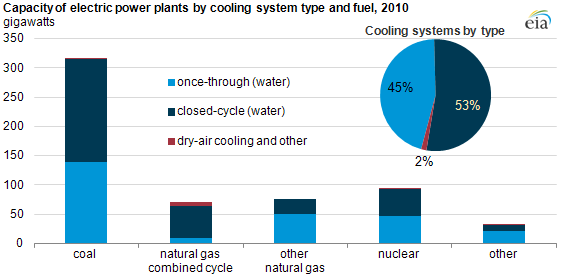
Over half the cooling systems at U.S. electric power plants reuse water

Note: Other includes petroleum combustion turbines as well as renewable sources such as biomass and wood-derived fuels. In 2011, EIA began collecting cooling system data from nuclear plants for 2010.
Download CSV Data
Electric power plants account for nearly half of water withdrawn every day in the United States, according to the U.S. Geological Survey's water use estimate. In March 2011, the U.S. Environmental Protection Agency (EPA) issued proposed standards for cooling systems that favor closed-cycle systems, while allowing regulators to consider both the costs and benefits of cooling system design in their application at each facility covered by the standards.
In general, thermoelectric power plants use cooling systems to cool down (condense) steam after it has been used to turn a steam turbine and generate power. There are three major categories of cooling systems:
- Closed-cycle cooling: Water is reused in a closed-cycle cooling systems. Evaporation from a nearby cooling tower removes heat from the power plant.
- Once-through cooling: In a once-through system, intake structures withdraw water, which is then run through the power plant for cooling. Once used, the water is discharged back into the body of water at a higher temperature. Both the water intake and thermal discharge can affect local aquatic wildlife.
- Dry-air cooling: Dry-air cooling systems use essentially no water for cooling purposes.
Overall, 53% of the electric generating capacity in the United States uses closed-cycle cooling systems. Most new power plants, like many combined-cycle natural gas plants, use closed-cycle cooling systems; many older natural gas- and coal-fired power plants use once-through cooling. As a result, the average age of a closed-cycle cooling system is 29 years, compared to 50 years for once-through systems. Once-through systems are more prevalent in eastern states, and closed-cycle systems are more common in western states.
Section 316(b) of the Clean Water Act requires facilities with cooling water intake structures to use the best technology available to mitigate the environmental impacts of the systems—specifically, damage to aquatic wildlife. The EPA issued proposed standards for comment on March 28, 2011. The proposed rule delegates implementation to state environmental regulators and allows them to consider both the costs and benefits of cooling system design in their application of its requirements at each facility, and therefore will most likely not require the use of closed-cycle cooling at all plants. EPA recently extended the comment period, and a final rule is not expected until next year.
The 2010 power plant water data presented above reflect steps taken by EIA to improve data collection, including, in part: collecting monthly rather than annual data, resuming collection of water data from nuclear power plants, expanding the number of combined-cycle plants required to report, and requiring plants to indicate whether data are estimated or measured. The 2010 power plant water data will be publicly released by the end of November.